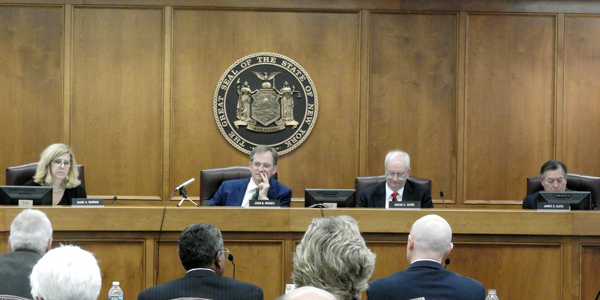ALBANY, N.Y. — About 194,000 customers in New York were without electric power in the state after a series of thunderstorms hit on May 15, the Public Service Commission heard Thursday.
The outages were mostly in the Lower Hudson Valley, the same area that suffered severe outages in March, said Michael Worden, director of the commission’s Office of Electric, Gas and Water.
“We have about 5,550 [full-time equivalents] of line, tree and service crews there providing support to the area,” Worden said. “That includes on the order of 1,250 out-of-state, out-of-region crews, and also includes a large contingent of New York crews that have been redeployed from, for example, Western New York. So there’s a significant recovery effort going on.”
By Saturday, most customers had had their power restored, with only about 13,600 still out, according to PowerOutage.us, which aggregates utility-reported outage data.
The commission is continuing to investigate the various utilities’ March outages and storm response efforts, Worden said.
Grid Ready for Summer
New York’s bulk electric system is prepared to reliably meet this summer’s load forecast, according to the Department of Public Service.
Department staff based its assessment on a review of utility data and meetings with individual utilities and NYISO, Vijay Puran, DPS senior engineer for electric transmission planning, told the commission.
“Utilities will complete all planned major reinforcements, inspections and repairs prior to the start of the summer season, and they have adequate spare equipment on hand to meet unforeseen circumstances,” Puran said during a presentation.
The ISO predicts demand will peak at 32,904 MW this summer. With a total resource capability of 42,169 MW on hand, the grid’s margin of safety comfortably exceeds the 18.2% required installed reserve margin, Puran said.
Peak demand forecasts have dropped by more than 3,000 MW since 2015, which the ISO “attributes to the positive effects of the state’s energy programs and to underlying forecast econometric growth rates,” he said.
Puran said hundreds of megawatts of load reduction are available to Consolidated Edison through its demand response programs, and other utilities have similar load-relief measures they can turn to if needed.
DPS staff expect the cost for electricity this summer to be higher than last year but 9 to 12% below the five-year average.
“I hear this as an outlook that is good news for New Yorkers, giving us comfort that we can confidently expect adequate supply and reasonable costs,” PSC Chair John B. Rhodes said.
National Grid Utilities Audit
In its consent agenda, the commission ordered a management and operations audit of three National Grid USA subsidiaries: Niagara Mohawk Power, Brooklyn Union Gas and KeySpan Gas East (18-M-0195). The effort will focus on construction program planning and operational efficiency.
“The audit will include an assessment of the utilities’ readiness to respond to the Reforming the Energy Vision initiative and closely examines how the utilities plan for and manage information systems projects,” Rhodes said in a statement. “The audit will also address issues from previous management audits that require follow-up review, such as organizational structure, project estimating processes and work management processes.”
Gov. Andrew Cuomo in 2013 highlighted the importance of management and operations audits of the state’s utilities, and introduced — and subsequently signed — legislation that required utilities to file plans for implementing audit recommendations.
This is the fourth comprehensive audit since 2013, and three additional audits are underway, the commission said.
“To date, these audits have recommended numerous productivity enhancements, better risk mitigation strategies, and improved planning processes, as well as other operational improvements at New York’s utilities,” the commission said. “These process improvements result in savings for customers over time, and those savings are captured in rate cases.”
— Michael Kuser







